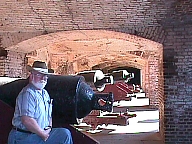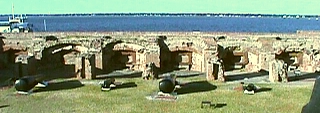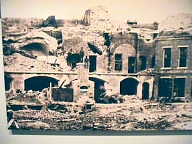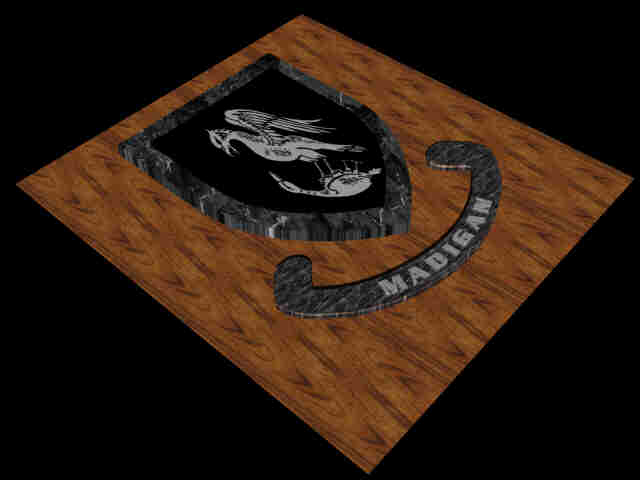Their demands that Fort
Sumpter be abandoned were ignored. By coincidence, one of the  finest
military schools in the nation (the Citadel), just happened to be
in Charleston. In the last days in office, President Buchanan
decided to reinforce the Fort Sumpter garrison. Hoping to avoid
direct confrontation he sent 200 soldiers, guns and ammunition by
a civilian side-wheeler intending to slip in and unload before
the southern defenders realized what was happening. This failed
to materialize when word was sent to Charleston of what was about
to transpire. And thus one of the neglected facts of the Civil
War occurred. Even the most novice war buff will quickly report
the first shot of the Civil Was fired AT
Fort Sumpter. At least one prominent military association
disputes this commonly accepted fact. The military college, the
Citadel, had sent
finest
military schools in the nation (the Citadel), just happened to be
in Charleston. In the last days in office, President Buchanan
decided to reinforce the Fort Sumpter garrison. Hoping to avoid
direct confrontation he sent 200 soldiers, guns and ammunition by
a civilian side-wheeler intending to slip in and unload before
the southern defenders realized what was happening. This failed
to materialize when word was sent to Charleston of what was about
to transpire. And thus one of the neglected facts of the Civil
War occurred. Even the most novice war buff will quickly report
the first shot of the Civil Was fired AT
Fort Sumpter. At least one prominent military association
disputes this commonly accepted fact. The military college, the
Citadel, had sent artillery instructors and students to one of
the shore batteries across from Fort Sumpter. When the Star of
the West, a side-wheeler loaded with troops and ammunitions
slipped into the harbor in January of 1861, the Citadel battery
fired the first shot of the war. The shots were light and
ineffective and the ship, now exposed, made a break for Fort
Sumpter but heavy guns from other batteries drove it off. In
March, one of the many ironies of the war occurred when General
P.G.T Beauregard took command of Confederate Forces in
Charleston. General Beauregard was Col. Anderson's artillery
instructor at West Point. When Lincoln took office, he
immediately sent a second re-enforcement ship, this time
supported with warships bent on relieving Fort Sumpter. The
Confederate Cabinet telegraphed Beauregard to fire on the Fort to
prevent it from being re-enforced. Beauregard demanded the
surrender of the Fort one last time and Anderson refused. With
nothing left to be said, at around 4:10 AM April 12th, 1861, by
order of Cap. George James
artillery instructors and students to one of
the shore batteries across from Fort Sumpter. When the Star of
the West, a side-wheeler loaded with troops and ammunitions
slipped into the harbor in January of 1861, the Citadel battery
fired the first shot of the war. The shots were light and
ineffective and the ship, now exposed, made a break for Fort
Sumpter but heavy guns from other batteries drove it off. In
March, one of the many ironies of the war occurred when General
P.G.T Beauregard took command of Confederate Forces in
Charleston. General Beauregard was Col. Anderson's artillery
instructor at West Point. When Lincoln took office, he
immediately sent a second re-enforcement ship, this time
supported with warships bent on relieving Fort Sumpter. The
Confederate Cabinet telegraphed Beauregard to fire on the Fort to
prevent it from being re-enforced. Beauregard demanded the
surrender of the Fort one last time and Anderson refused. With
nothing left to be said, at around 4:10 AM April 12th, 1861, by
order of Cap. George James  of the Cummings Point battery, Edmond Ruffin, a
gunner fired the first shot against Fort Sumpter and the
bombardment was on. The cannonade continued throughout the night.
The next morning a hot shot from Fort Moultrie set fire to the
officer's quarters. In early afternoon the flagstaff was shot
away. That evening Col. Anderson surrendered his garrison.
Miraculously, not one man on either side had been killed. Col.
Anderson and complement were allowed to withdraw by ship to New
York. The Confederacy immediately took over the Fort and added
the larger Parrot rifled cannon to its defense. For the next 4
years, the Fort would stand as a thorn in the Union side. Over
and over warships would sail in and engage only to be driven off.
By January 1865, with only months left in the war, the Fort had
still not fallen. An almost continuous 22 month bombardment from
Union land guns had failed to bring about its surrender. During
that time
of the Cummings Point battery, Edmond Ruffin, a
gunner fired the first shot against Fort Sumpter and the
bombardment was on. The cannonade continued throughout the night.
The next morning a hot shot from Fort Moultrie set fire to the
officer's quarters. In early afternoon the flagstaff was shot
away. That evening Col. Anderson surrendered his garrison.
Miraculously, not one man on either side had been killed. Col.
Anderson and complement were allowed to withdraw by ship to New
York. The Confederacy immediately took over the Fort and added
the larger Parrot rifled cannon to its defense. For the next 4
years, the Fort would stand as a thorn in the Union side. Over
and over warships would sail in and engage only to be driven off.
By January 1865, with only months left in the war, the Fort had
still not fallen. An almost continuous 22 month bombardment from
Union land guns had failed to bring about its surrender. During
that time  an estimated 7 million pounds of metal had been
slammed into the fort walls reducing them to rubble. Fifty-seven
confederate defenders were dead and 267 had been wounded. With
Sherman marching to Georgia, the Fort was finally abandoned and
the saga ended. Access to the Fort is by ferry which leaves from
the Fort Sumpter Memorial and Museum three or four times a day.
The total trip is 2 1/4 hours with one hour on the Island itself.
It is a national park and run by the Rangers along with several
other sites around the harbor. Some of the original works remain.
There intentionally has been little done other then stabilization
to return the Fort to its original glory. Still and all, it is a
most historical place and as such earns the interest of half a
million travelers each year.
an estimated 7 million pounds of metal had been
slammed into the fort walls reducing them to rubble. Fifty-seven
confederate defenders were dead and 267 had been wounded. With
Sherman marching to Georgia, the Fort was finally abandoned and
the saga ended. Access to the Fort is by ferry which leaves from
the Fort Sumpter Memorial and Museum three or four times a day.
The total trip is 2 1/4 hours with one hour on the Island itself.
It is a national park and run by the Rangers along with several
other sites around the harbor. Some of the original works remain.
There intentionally has been little done other then stabilization
to return the Fort to its original glory. Still and all, it is a
most historical place and as such earns the interest of half a
million travelers each year.
*** THE END ***

